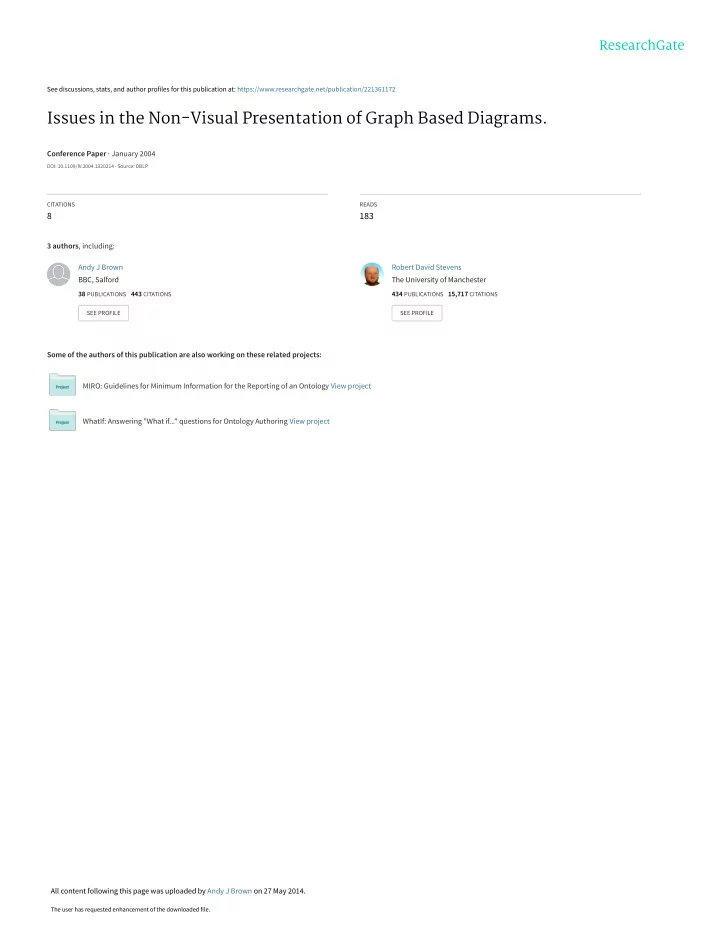

See discussions, stats, and author profiles for this publication at: https://www.researchgate.net/publication/221361172 Issues in the Non-Visual Presentation of Graph Based Diagrams. Conference Paper · January 2004 DOI: 10.1109/IV.2004.1320214 · Source: DBLP CITATIONS READS 8 183 3 authors , including: Andy J Brown Robert David Stevens BBC, Salford The University of Manchester 38 PUBLICATIONS 443 CITATIONS 434 PUBLICATIONS 15,717 CITATIONS SEE PROFILE SEE PROFILE Some of the authors of this publication are also working on these related projects: MIRO: Guidelines for Minimum Information for the Reporting of an Ontology View project WhatIf: Answering "What if..." questions for Ontology Authoring View project All content following this page was uploaded by Andy J Brown on 27 May 2014. The user has requested enhancement of the downloaded file.
Issues in the Non-Visual Presentation of Graph Based Diagrams Andy Brown, Robert Stevens, Steve Pettifer Department of Computer Science, University of Manchester, Oxford Road, Manchester M13 9PL. UK browna@cs.man.ac.uk, rds@cs.man.ac.uk, srp@cs.man.ac.uk Abstract cess flowcharts, universal modelling language (UML) dia- grams, organisational structure hierarchies, molecular struc- tures and biological diagrams such as the nitrogen cycle. One aspect of non-visual visualisation is providing ac- These graphs do not include Cartesian type graphs express- cessibility to diagrams for users with visual impairments. ing numerical correlation between quantities; rather they are In this paper we review the literature on diagrams and non- used to present a more or less abstract view of relationships visual presentation in order to elucidate the issues involved between entities. An important result of this distinction is in making graph based diagrams accessible using speech that the diagram layout is not important: the information is and non-speech sound. First we examine the nature, scope contained in the knowledge of which nodes are connected and uses of these diagrams. We then describe the nature of to which others by which edges, and any attributes of the diagrams: how do diagrams differ from other representa- nodes and connections. This is not to say that layout can- tions; how do sighted readers read, understand, and extract not be used to ease reading of the diagram. Conversely, it information from diagrams; what cognitive processes do di- is also important to note that layout and presentation can agrams facilitate; and what factors affect how diagrams be (to some extent) simply an artefact of the presentation may be understood? After a comparison of visual with au- medium, not an inherent part of the information. ral presentation we discuss the work presented by others in Graphs are ubiquitous, yet for users unable to see them this field, particularly looking at their reasons for imple- menting how they do in light of our examination of visual clearly, due to either visual impairments, difficult environ- comprehension. The paper concludes with a discussion of ments, or hardware limitations, they may become unusable. how these issues combine and conflict to influence require- To put this in context, it is estimated that there are over ments for interface design. 150,000 visually impaired people in the U.K., and their rights of access to information have been enshrined in law. Can the design of interfaces for such users be influenced by combining an understanding of the nature of visual di- 1. Introduction agrammatic representation (how these representations are understood and how they benefit readers) with appreciation Graphs form the basic component of many diagrams and of the differences between the visual and audio channels? the ability to provide non-visual visualisation of graphs is vital if print disabled readers are to be able to use this form 2. The Nature and Uses of Graphs of diagram. This paper discusses how graphs are understood by sighted readers before examining some of the issues in- As an example of a graph, consider Figure 1, which volved with, and previous efforts into, making them acces- shows the structure of the molecule ethanoic acid. In this sible through audio presentation. The Shorter Oxford English Dictionary [18] de- fines ‘graph’ as: ‘2 MATH . A symbolic diagram in which connec- tions between items are represented by lines. Now also in abstract terms, a finite, non-empty set of elements together with a set of unordered pairs of Figure 1. Diagram showing the structure of these elements.’ ethanoic acid. This may be summarised by saying a graph is composed of a collection of nodes and edges. Examples include pro-
Recommend
More recommend